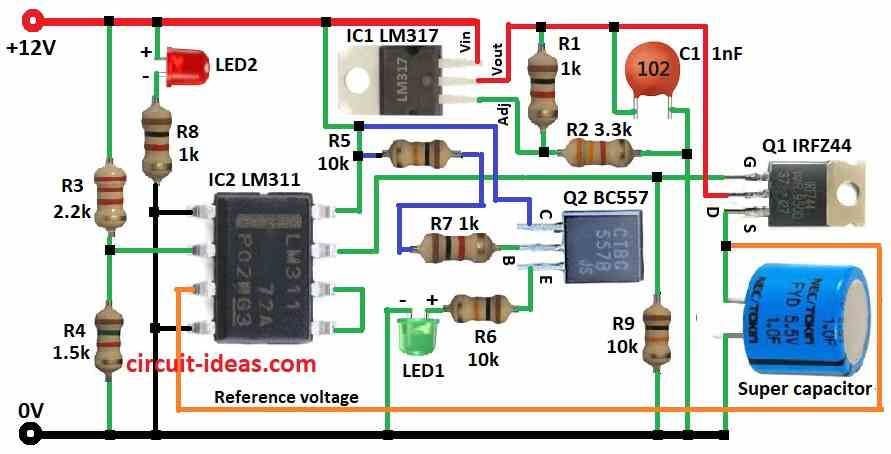We can charge supercapacitor safe and proper with and simple and easy to make Supercapacitor Charger Circuit.
Battery does not charges or drain fast.
Supercapacitor can do fast charge and drain.
But supercapacitor hold less energy than battery.
Circuit uses voltage regulator chip like LM317 to control voltage to supercapacitor.
Regulator checks supercapacitor voltage and compare with reference and then changes output voltage.
Circuit Working:

Parts List:
| Component Type | Description | Quantity |
|---|---|---|
| Resistors | 1k 1/4 watt | 3 |
| 10k 1/4 watt | 3 | |
| 2.2k 1/4 watt | 1 | |
| 1.5k 1/4 watt | 1 | |
| 3.3k 1/4 watt | 1 | |
| Capacitors | Ceramic 1nF | 1 |
| Supercapacitor 5.5V 1F | 1 | |
| Semiconductors | IC LM317 | 1 |
| IC LM311 | 1 | |
| MOSFET IRFZ44 | 1 | |
| Transistor BC557 | 1 | |
| LED Red 5mm 20mA | 1 | |
| LED Green 5mm 20mA | 1 |
This circuit uses 12V DC from wall adaptor.
LM317 regulator change 12V to 5.5V to charge supercapacitor safe and correct.
MOSFET works like switch and send 5.5V to capacitor.
MOSFET controlled by voltage divider with resistors R2 and R3.
For current to flow LM311 pin 3 voltage must be less than 4.86V.
Voltage divider makes 4.86V from 12V source.
LM311 check this voltage while capacitor charging.
When capacitor goes above 4.86V then IC LM311 pin 7 goes low and turn OFF the MOSFET and stop charging to prevent overcharge.
No op-amp is needed for voltage control.
BC557 PNP transistor is used for LED.
When charging is done voltage > 4.8V then the MOSFET is OFF and LED turns ON to show capacitor is full.
Formula:
LM317 Output Voltage Formula:
Vout = 1.25 * (1 + R2 / R1)
here:
- Vout is output voltage and we want 5.5V.
- R1 is first resistor for example 1k.
- R2 is second resistor for example 3.3k.
By changing R1 and R2 we can change output voltage.
In this circuit 1k and 3.3k resistors give near 5.5V which is good for charging the supercapacitor.
Note:
This formula works only for LM317 not for other regulators.
How to Build:
To build a Simple Supercapacitor Charger Circuit we need to follow the below mentioned connections steps:
- Put all parts same like in circuit diagram.
- Connect IC1 pin 1 to capacitor C1 using resistors R1 and R2.
- Connect IC1 pin 2 to MOSFET Q1 drain.
- Connect IC1 pin 3 to +12V power.
- Connect IC2 pin 1 and pin 4 to ground.
- Connect IC2 pin 2 between resistors R3 and R4.
- Connect IC2 pin 3 to reference voltage.
- Connect IC2 pin 5 and pin 6 together.
- Connect IC2 pin 7 to gate of MOSFET Q1.
- Connect IC2 pin 8 to +12V power.
- Connect gate of MOSFET Q1 to IC2 pin 7.
- Connect drain of Q1 to Vout of IC1.
- Connect source of Q1 to ground through supercapacitor.
- Connect Q2 transistor collector to IC2 pin 8.
- Connect Q2 base to IC2 pin 8 through resistors R5 and R7.
- Connect emitter of Q2 to ground through resistor R6 and green LED1.
- Connect LED2 and resistor R8 from +12V to ground.
- Connect resistor R9 from gate of Q1 to ground.
- Connect capacitor C1 from IC1 Vout to ground.
Conclusion:
This Supercapacitor Charger Circuit charges supercapacitor safe and correct.
LM317 give stable voltage inside safe range of capacitor.
MOSFET act like smart gate and let current go only when charge is needed.
LM311 keep watching capacitor voltage and when the voltage goes high then it stop charging to avoid overcharge.
When charging is finished then BC557 transistor turns ON the LED to show capacitor is full.
Leave a Reply